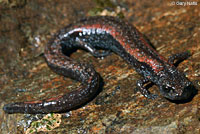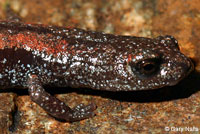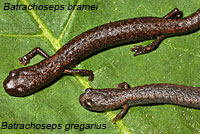|

| Adult, upper Kern River Canyon north of Fairview, Tulare County |
 |
 |
 |
| Adult, upper Kern River Canyon north of Fairview, Tulare County |
 |
 |
 |
| Adult, upper Kern River Canyon north of Fairview, Tulare County |
 |
 |
 |
| Adult, upper Kern River Canyon, south of Fairview, Tulare County |
 |
 |
 |
| Adult, upper Kern River Canyon, south of Fairview, Tulare County |
Adult in a defensive coil, upper Kern River Canyon north of Fairview,
Tulare County |
 |
 |
 |
| Adults, upper Kern River Canyon, south of Fairview, Tulare County |
Underside of adult, upper Kern River Canyon north of Fairview,
Tulare County |
| |
 |
|
| |
Adult, Tulare County © Ryan Sikola |
|
| |
|
|
| Comparison With a Similar Sympatric Species |
| |
 |
|
| |
Top: B. bramei
Bottom: B. gregarius - Gregarious Slender Salamander
B. gregarius has a slimmer body with smaller feet and toes. |
|
| |
|
|
| Habitat |
 |
 |
 |
Habitat, Upper Kern River
Canyon, Tulare County |
Habitat, Upper Kern River
Canyon, Tulare County
|
Habitat, Fairview, 3,500 ft.,
Tulare County |
 |
 |
|
Habitat, upper Kern River
Canyon, Tulare County |
Habitat, 3,700 ft.,
Tulare County
|
|
| |
|
|
| Short Video |
| |
 |
|
| |
A tiny juvenile under a rock. |
|
|
|
|
| Description |
| |
| Size |
Females average 1.4 inches (35.5 mm) in length from snout to vent, males average of 1.35 inches (34.3 mm) in length.
|
| Appearance |
A small slender salamander with a relatively broad flattened head and long legs with relatively large feet.
The tail is relatively short and rarely exceeds the total body length.
Short limbs, a narrow head, long slender body, very long tail, and conspicuous costal and caudal grooves give this species the worm-like appearance typical of most Slender Salamanders.
This species is relatively large and robust when compared with many Slender Salamanders, having a comparatively broader head, longer legs, broader feet, and larger toes.
There are four toes on the front and hind feet, which is also typical of Slender Salamanders.
(Other California salamanders have five toes on the hind feet.)
Has 1-3 fewer trunk vertebrae, a longer broader head, and larger limbs with larger feet than neighboring B. simatus. |
| Color and Pattern |
Color is black to brownish black, with silvery to gold or brassy metallic speckles. Coloring may give the appearance of a dorsal stripe. Uniformly flat black underneath with metallic speckling.
|
| Life History and Behavior |
A member of family Plethodontidae, the Plethodontid or Lungless Salamanders.
Plethodontid salamanders do not breathe through lungs. They conduct respiration through their skin and the tissues lining their mouth. This requires them to live in damp environments on land and to move about on the ground only during times of high humidity. (Plethodontid salamanders native to California do not inhabit streams or bodies of water but they are capable of surviving for a short time if they fall into water.)
Plethodontid salamanders are also distinguished by their nasolabial grooves, which are vertical slits between the nostrils and upper lip that are lined with glands associated with chemoreception.
All Plethodontid Salamanders native to California lay eggs in moist places on land.
The young develop in the egg and hatch directly into a tiny terrestrial salamander with the same body form as an adult.
(They do not hatch in the water and begin their lives as tiny swimming larvae breathing through gills like some other types of salamanders.) |
| Activity |
Little is known about this species.
This species has been observed active at night during winter and early spring
found beneath surface objects under snow.
Most Slender Salamander species are active on rainy or wet nights when temperatures are moderate, fall through spring, retreating underground when the soil dries or when air temperature drops to near freezing.
At higher elevations, activity may be restricted to spring and early summer and early fall.
Individuals are typically found beneath rocks, logs, bark and leaf-litter during periods of high moisture, November to March or April, but often only February and March.
|
| Defense |
Slender salamanders use several defense tactics, including:
- Coiling and remaining still, relying on cryptic coloring to avoid detection.
- Uncoiling quickly and springing away repeatedly bouncing over the ground, then remaining still again to avoid detection.
- Detaching the tail, which wriggles on the ground to distract a predator from the salamander long enough for it to escape.
(After its tail is detached or severed, the salamander will grow a new tail.) |
| Diet and Feeding |
Probably eats a variety of small invertebrates.
Feeding behavior is not well known, but other Batrachoseps species are sit-and-wait predators that use a projectile tongue to catch prey. |
| Reproduction |
Reproduction is terrestrial.
Nothing is known of the reproduction of B. bramei.
Like other low to mid- elevation Slender Salamanders, it is assumed that this species lays eggs on land between December and February, depending on stimulation by rainfall, which varies year to year.
Young presumably hatch in early spring, fully formed.
|
| Habitat |
Favors north-facing talus-covered slopes in narrow canyons. These areas typically do not get sun in winter and remain moist and cool into the spring.
|
| Geographical Range |
Endemic to California. Found only in the Upper Kern River Canyon along the west side of Lake Isabella, on the east and west sides of the river, from Wofford Heights north to 1 kilometer north of where South Falls Creek flows into the Kern River.
May be found to range farther north where surveys have not been thorough.
Not found in sympatry with any other slender salamander species.
The nearest B. simatus locality is 13 km south.
B. robustus has been found 7 km east, but at a much higher elevation. |
| Elevational Range |
Found at elevations of 2821 - 4200 ft. (860-1280 m.)
|
| Notes on Taxonomy |
Upper Kern River Canyon slender salamanders have been recognized as morphologically different from B. simatus - Kern Canyon Slender Salamander, since Brame and Murray's work in 1968. They have been included with B. simatus, but mostly treated as a unique species pending a formal description. The species description was eventually published in February 2012 by Jockush, et al. *
Here's a Diagram of the Batrachoseps Complex showing the relationships between species.
Alternate and Previous Names (Synonyms)
Batrachoseps simatus - Kern Canyon Slender Salamander (Stebbins1985, 2003, 2012)
|
| Conservation Issues (Conservation Status) |
| Jockusch et al mention that the species might be subject to negative impacts from heavy fire-suppression equipment and road maintenance, but that it is apparently more abundant and more easily found than B. simatus which is listed as a Threatened Species. |
|
|
Taxonomy |
| Family |
Plethodontidae |
Lungless Salamanders |
Gray, 1850 |
| Genus |
Batrachoseps |
Slender Salamanders |
Bonaparte, 1841 |
Species
|
bramei |
Fairview Slender Salamander |
Jockush, Martinez-Solano, Hansen, and Wake, 2012 |
|
Original Description |
Jokusch et al., 2012, Zootaxa 3190: 1-30.
Brame and Murray 1968:16 B. simatus (part)
|
|
Meaning of the Scientific Name
|
Batrachoseps - Greek - batrachos = amphibian, frog + seps = lizard — describes lizard-like appearance
bramei - Honors Arden H. Brame Jr.
|
|
Related or Similar California Herps
|
Similar Neighboring Salamanders
Batrachoseps kawia
Batrachoseps regius
Batrachoseps robustus
Batrachoseps simatus
Batrachoseps gregarious
Batrachoseps altasierrae
Batrachoseps relictus
Batrachoseps stebbensi
|
|
More Information and References
|
* Jokusch, Elizabeth L., Inigo Martinez-Solano, Robert W. Hansen, & David B. Wake.
Morphological and molecular diversification of slender salamanders (Caudata: Plethodontidae: Batrachoseps) in the southern Sierra Nevada of California with descriptions of two new species.
© 2012 - Magnolia Press Zootaxa 3190: 1-30 (2012) www.mapress.com/zootaxa/
Salamander Diversity in the Kern Valley Region
Hansen, Robert W. Kern River Research Area Field Notes Spring 1997 Vol. 6, No. 2
Hansen, Robert W. and Shedd, Jackson D. California Amphibians and Reptiles. (Princeton Field Guides.) Princeton University Press, 2025.
Stebbins, Robert C., and McGinnis, Samuel M. Field Guide to Amphibians and Reptiles of California: Revised Edition (California Natural History Guides) University of California Press, 2012.
Stebbins, Robert C. California Amphibians and Reptiles. The University of California Press, 1972.
Flaxington, William C. Amphibians and Reptiles of California: Field Observations, Distribution, and Natural History. Fieldnotes Press, Anaheim, California, 2021.
Nicholson, K. E. (ed.). 2025. Scientific and Standard English Names of Amphibians and Reptiles of North America North of Mexico, with Comments Regarding Confidence in Our Understanding. Ninth Edition. Society for the Study of Amphibians and Reptiles. [SSAR] 87pp.
Samuel M. McGinnis and Robert C. Stebbins. Peterson Field Guide to Western Reptiles & Amphibians. 4th Edition. Houghton Mifflin Harcourt Publishing Company, 2018.
Stebbins, Robert C. A Field Guide to Western Reptiles and Amphibians. 3rd Edition. Houghton Mifflin Company, 2003.
Behler, John L., and F. Wayne King. The Audubon Society Field Guide to North American Reptiles and Amphibians. Alfred A. Knopf, 1992.
Robert Powell, Roger Conant, and Joseph T. Collins. Peterson Field Guide to Reptiles and Amphibians of Eastern and Central North America. Fourth Edition. Houghton Mifflin Harcourt, 2016.
Powell, Robert., Joseph T. Collins, and Errol D. Hooper Jr. A Key to Amphibians and Reptiles of the Continental United States and Canada. The University Press of Kansas, 1998.American Museum of Natural History - Amphibian Species of the World 6.2
Bartlett, R. D. & Patricia P. Bartlett. Guide and Reference to the Amphibians of Western North America (North of Mexico) and Hawaii. University Press of Florida, 2009.
Bishop, Sherman C. Handbook of Salamanders. Cornell University Press, 1943.
Lannoo, Michael (Editor). Amphibian Declines: The Conservation Status of United States Species. University of California Press, June 2005.
Petranka, James W. Salamanders of the United States and Canada. Smithsonian Institution, 1998.
Thelander, C. G., ed. Life on the Edge: A Guide to California's Endangered Natural Resources Volume I: Wildlife.
Biosystems Books, Santa Cruz, California. 1994.
Elizabeth L. Jockusch and David B. Wake
Falling apart and merging: diversification of slender salamanders (Plethodontidae: Batrachoseps) in the American West
Biological Journal of the Linnean Society, 2002, 76, 361–391. 14 March 2002
|
|
|
The following conservation status listings for this animal are taken from the July 2025 State of California Special Animals List and the July 2025 Federally Listed Endangered and Threatened Animals of California list (unless indicated otherwise below.) Both lists are produced by multiple agencies every year, and sometimes more than once per year, so the conservation status listing information found below might not be from the most recent lists, but they don't change a great deal from year to year.. To make sure you are seeing the most recent listings, go to this California Department of Fish and Wildlife web page where you can search for and download both lists:
https://www.wildlife.ca.gov/Data/CNDDB/Plants-and-Animals.
A detailed explanation of the meaning of the status listing symbols can be found at the beginning of the two lists. For quick reference, I have included them on my Special Status Information page.
If no status is listed here, the animal is not included on either list. This most likely indicates that there are no serious conservation concerns for the animal. To find out more about an animal's status you can also go to the NatureServe and IUCN websites to check their rankings.
Check the current California Department of Fish and Wildlife sport fishing regulations to find out if this animal can be legally pursued and handled or collected with possession of a current fishing license. You can also look at the summary of the sport fishing regulations as they apply only to reptiles and amphibians that has been made for this website.
|
| Organization |
Status Listing |
Notes |
| NatureServe Global Ranking |
G3 |
Vulnerable—At moderate risk of extinction due to a restricted range, relatively few populations (often 80 or fewer), recent and widespread declines, or other factors.
|
| NatureServe State Ranking |
S3 |
Vulnerable in the state due to a restricted range, relatively few populations (often 80 or fewer), recent and widespread declines, or other factors making it vulnerable to extirpation from the state.
|
| U.S. Endangered Species Act (ESA) |
None |
|
| California Endangered Species Act (CESA) |
None |
|
| California Department of Fish and Wildlife |
None |
|
| Bureau of Land Management |
None |
|
| USDA Forest Service |
S |
Sensitive |
| IUCN |
None |
|
|
|


























